-
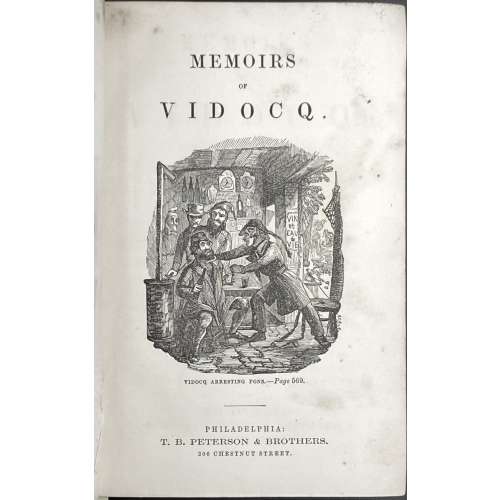 Title: MEMOIRS | OF | VIDOCQ. |THE | Principal Agent of the French Police. | WRITTEN BY HIMSELF, | AND TRANSLATED FROM THE | ORIGINAL FRENCH, EXPRESSLY FOR THIS EDITION. | WITH ILLUSTRATIVE ENGRAVINGS, | FROM | ORIGINAL DESIGNS BY CRUIKSHANK. | PHILADELPHIA: | T. B. PETERSON AND BROTHERS, | 306 CHESTNUT STREET. || Pagination: ffl, engraved frontispiece w/guard, engraved t.p., [2] t.p. / copyright, 19-580, [12], [2] 3-17 [18-30], bfl + 4 plates. Collation: 8vo; [1]8 2-358 362 + 22 leaves of advert., + frontis., t.p., 4 plates. Correct collation despite pagination starts at p. 19. Binding: Publisher's brown pebbled cloth, front stamped in blind, gilt spine lettering, yellow endpapers. Owner's ink inscription to ffl, dated 1936. Ref.: HathiTrust and OCLC identify the plates as 'by George Cruikshank' though none is signed. Authorship of Eugène-François Vidocq (French, 1775 – 1857) is doubtful too. The translator is not stated.
Title: MEMOIRS | OF | VIDOCQ. |THE | Principal Agent of the French Police. | WRITTEN BY HIMSELF, | AND TRANSLATED FROM THE | ORIGINAL FRENCH, EXPRESSLY FOR THIS EDITION. | WITH ILLUSTRATIVE ENGRAVINGS, | FROM | ORIGINAL DESIGNS BY CRUIKSHANK. | PHILADELPHIA: | T. B. PETERSON AND BROTHERS, | 306 CHESTNUT STREET. || Pagination: ffl, engraved frontispiece w/guard, engraved t.p., [2] t.p. / copyright, 19-580, [12], [2] 3-17 [18-30], bfl + 4 plates. Collation: 8vo; [1]8 2-358 362 + 22 leaves of advert., + frontis., t.p., 4 plates. Correct collation despite pagination starts at p. 19. Binding: Publisher's brown pebbled cloth, front stamped in blind, gilt spine lettering, yellow endpapers. Owner's ink inscription to ffl, dated 1936. Ref.: HathiTrust and OCLC identify the plates as 'by George Cruikshank' though none is signed. Authorship of Eugène-François Vidocq (French, 1775 – 1857) is doubtful too. The translator is not stated. -
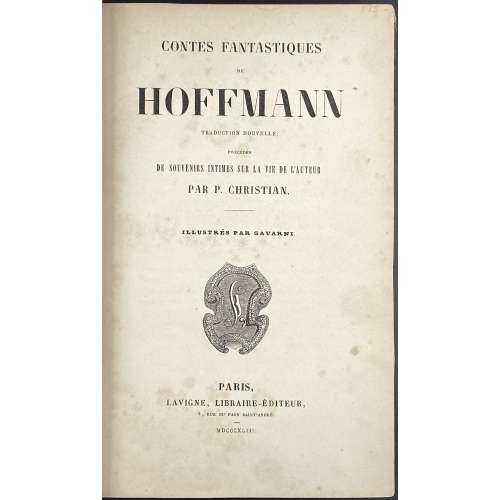 Title: CONTES FANTASTIQUES | DE | HOFFMANN | TRADUCTION NOUVELLE ; PRÉCÉDÉS | DE SOUVENIRS INTIMES SUR LA VIE DE L’AUTEUR | PAR P. CHRISTIAN. | ILLUSTRÉS PAR GAVARNI. | {Publisher’s device} | — PARIS, | LAVIGNE, LIBRAIRE-ÉDITEUR, | 1 RUE DU PAON SAINT-ANDRÉ. | MDCCCXLIII. || Pagination: ffl, [i-vi] –h.t. / colopon, t.p. /blank, dedication /blank, [vii] viii-xix [xx][1,-3] 4-522, bfl, + woodcut illustrations by Brévière et Novionafter Gavarni: 10 full page plates, initials, tail pieces, and in text. Collation: [a]-b4 c2, 1-654 661. Binding: Quarter brown morocco over marbled boards, raised bands with gilt double fillets, gilt arabesque in compartments, title lettering. Catalogue raisonné: L. Carteret (1927), p. 295.
Title: CONTES FANTASTIQUES | DE | HOFFMANN | TRADUCTION NOUVELLE ; PRÉCÉDÉS | DE SOUVENIRS INTIMES SUR LA VIE DE L’AUTEUR | PAR P. CHRISTIAN. | ILLUSTRÉS PAR GAVARNI. | {Publisher’s device} | — PARIS, | LAVIGNE, LIBRAIRE-ÉDITEUR, | 1 RUE DU PAON SAINT-ANDRÉ. | MDCCCXLIII. || Pagination: ffl, [i-vi] –h.t. / colopon, t.p. /blank, dedication /blank, [vii] viii-xix [xx][1,-3] 4-522, bfl, + woodcut illustrations by Brévière et Novionafter Gavarni: 10 full page plates, initials, tail pieces, and in text. Collation: [a]-b4 c2, 1-654 661. Binding: Quarter brown morocco over marbled boards, raised bands with gilt double fillets, gilt arabesque in compartments, title lettering. Catalogue raisonné: L. Carteret (1927), p. 295. -
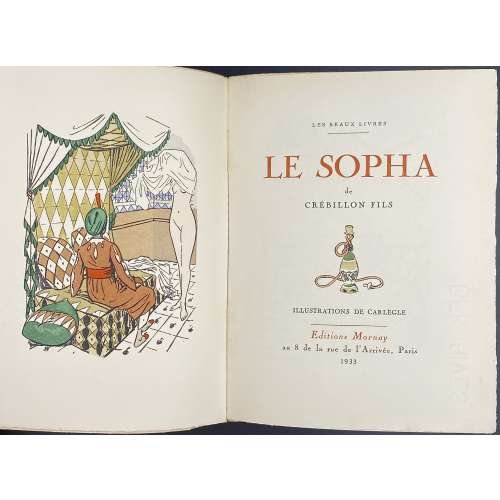 Title: LES BEAUX LIVRES | — | LE SOPHA | de | CRÉBILLON FILS |{vignette}| ILLUSTRATIONS DE CARLÈGLE | — | Éditions Mornay | au 8 de la rue de l’Arrivée, Paris | 1933 || Series: Les beaux livres Binding: Original pictorial wrappers, margins untrimmed, uncut; printed on BFK Rives paper (watermark); the number of copy blacked out. Justification of the print run on p. [329].Pagination: [1-8] 9-326 [327-331], ill., woodcuts in text. Size: 20.2 x 15.5 cm
Title: LES BEAUX LIVRES | — | LE SOPHA | de | CRÉBILLON FILS |{vignette}| ILLUSTRATIONS DE CARLÈGLE | — | Éditions Mornay | au 8 de la rue de l’Arrivée, Paris | 1933 || Series: Les beaux livres Binding: Original pictorial wrappers, margins untrimmed, uncut; printed on BFK Rives paper (watermark); the number of copy blacked out. Justification of the print run on p. [329].Pagination: [1-8] 9-326 [327-331], ill., woodcuts in text. Size: 20.2 x 15.5 cm -
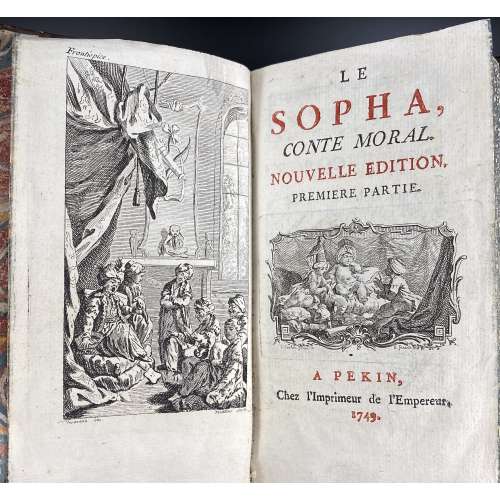 Title-page in black and red: LE | SOPHA, | CONTE MORAL. | NOUVELLE EDITION. | PREMIERE PARTIE. | {vignette} | A PEKIN, | Chez l'imprimeur de l'Empereur, | 1749. || Pagination: Two volumes in one. [2] – blanks, [2] – blank / frontis., [i, ii] – t.p. / blank, [iii] iv-xxi [xxii] ; [1] 2-253, [254-256] – table / blank, [2] – blanks; [i, ii] f.t. (seconde partie). [iii] 4-237 [238-240] – table / blank, [2] – blanks ; ills. 1 frontispiece, 4 plates and 2 vignettes by Pelletier after Clavereau, 2 fleurons by Fessard after Cochin. Collation: 12mo; a12, A8B4–T8V4, X8 [*1]; A8B4–T8V4. Binding: Full mottled calf, flat spine, compartments double-ruled in gilt, gilt flowers and foliage in compartments, crimson title label; marbled endpapers. Printed on laid paper, watermarked. Size: 14.8 x 8.8 cm Catalogue raisonné: Cohen, de Ricci (266); J. Lewine (124-5).
Title-page in black and red: LE | SOPHA, | CONTE MORAL. | NOUVELLE EDITION. | PREMIERE PARTIE. | {vignette} | A PEKIN, | Chez l'imprimeur de l'Empereur, | 1749. || Pagination: Two volumes in one. [2] – blanks, [2] – blank / frontis., [i, ii] – t.p. / blank, [iii] iv-xxi [xxii] ; [1] 2-253, [254-256] – table / blank, [2] – blanks; [i, ii] f.t. (seconde partie). [iii] 4-237 [238-240] – table / blank, [2] – blanks ; ills. 1 frontispiece, 4 plates and 2 vignettes by Pelletier after Clavereau, 2 fleurons by Fessard after Cochin. Collation: 12mo; a12, A8B4–T8V4, X8 [*1]; A8B4–T8V4. Binding: Full mottled calf, flat spine, compartments double-ruled in gilt, gilt flowers and foliage in compartments, crimson title label; marbled endpapers. Printed on laid paper, watermarked. Size: 14.8 x 8.8 cm Catalogue raisonné: Cohen, de Ricci (266); J. Lewine (124-5). -
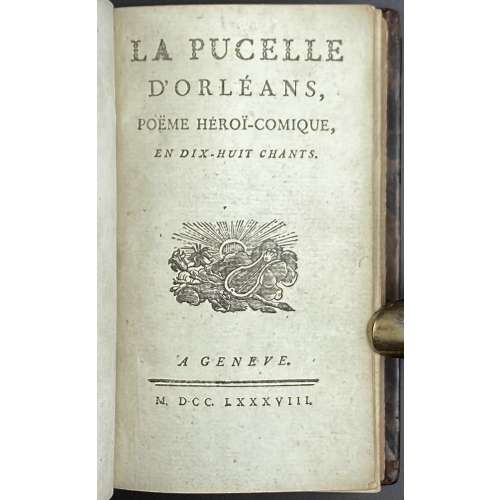 LA PUCELLE | D'ORLÉANS, | POËME HÉROÏ-COMIQUE, | EN DIX-HUIT CHANTS. |{vignette}| A GENEVE. | M. DCC.LXXXVIII.|| Pagination: engraved frontis., engraved portrait, [1, 2] – t.p. / blank, [3] 4-304; plates: engraved frontispiece, engraved portrait of Jeanne d'Arc and 18 engraved plates (the so-called 'suite anglaise' by Marillier, Clément-Pierre (French, 1740 – 1808) after Duflos, Pierre (French, 1742 – 1816). Publisher: Cazin, Hubert-Martin (French, 1724 – 1795). Modern binding to imitate full mottled calf of the 18th century, gilt double-ruled boards, gilt decorated spine with the crimson label “LA PUCELLE”, AEG, laid paper. Size: 13.3 x 8.7 cm; 18mo. Catalogue raisonné: Cohen, De Ricci 1032 (for 1777 and 1780 editions). J. Lewine p.559 (for 1777 16mo and even 12mo editions). The 'correct' 1st thus edition is called suite anglaise because instead of 'chant number' it's printed 'book number' on top of the pages. This copy is definitely a later pirated edition.
LA PUCELLE | D'ORLÉANS, | POËME HÉROÏ-COMIQUE, | EN DIX-HUIT CHANTS. |{vignette}| A GENEVE. | M. DCC.LXXXVIII.|| Pagination: engraved frontis., engraved portrait, [1, 2] – t.p. / blank, [3] 4-304; plates: engraved frontispiece, engraved portrait of Jeanne d'Arc and 18 engraved plates (the so-called 'suite anglaise' by Marillier, Clément-Pierre (French, 1740 – 1808) after Duflos, Pierre (French, 1742 – 1816). Publisher: Cazin, Hubert-Martin (French, 1724 – 1795). Modern binding to imitate full mottled calf of the 18th century, gilt double-ruled boards, gilt decorated spine with the crimson label “LA PUCELLE”, AEG, laid paper. Size: 13.3 x 8.7 cm; 18mo. Catalogue raisonné: Cohen, De Ricci 1032 (for 1777 and 1780 editions). J. Lewine p.559 (for 1777 16mo and even 12mo editions). The 'correct' 1st thus edition is called suite anglaise because instead of 'chant number' it's printed 'book number' on top of the pages. This copy is definitely a later pirated edition. -
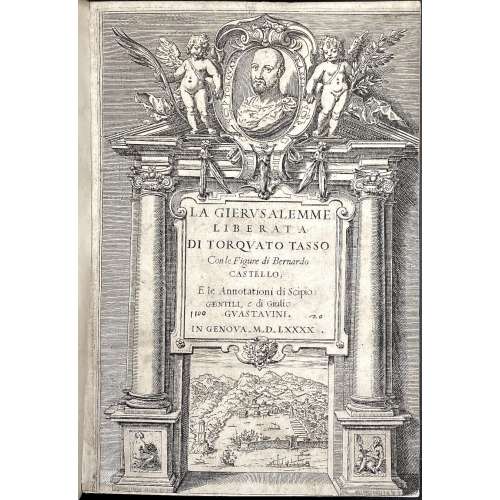 Engraved title with the portrait of Torquato Tasso, displayed in an oval medallion, bound in “TORQUATO TASSO”, between two naked putti; Architecture with two columns and Ionic capitals supporting an architectural pediment; between the columns is a table with the inscription: LA GIERVSALEMME | LIBERATA | DI TORQVATO TASSO | Con le Figure di Bernardo | CASTELLO; | E le Annotazioni di Scipio | GENTILI, e di Giulio | GVASTAVINI. | IN GENOVA. M.D.LXXXX .|| Contents: The 20 cantos are followed by: Tutte le stanza intere, che dall'autore sono state refiutate in questo libro; Annotationi di Scipio Gentili; Luoghi osservati dal mag. Giulio Guastavini, quali il Tasso nella sua Gierusalemme hà presi & imitati da poeti & altri scrittori antichi; Allegoria del poema; Tavola di tutti i nomi proprii et di tutte le materie principali contenute nel presente libro. Pagination: [2] engraved t.p. / blank, 3-11, [1] 2-255 [256], 1-71 [72] [1] 2-40, 4 unpag. leaves ‘Allegoria del poema’; total 387 pp. Collation: 8vo; π6 A-Q8 A-D8 E4 A-B8 χ4 (in the first quire M4 marked L4), ills. signed in collation. At p. 17 canto 3rd marked as 2nd, pp. 135 and 139 in 12th canto marked as 11th. Binding: later full polished calf, blind double-ruled covers, blind double-ruled raised bands, gilt lettering: GIERVSALEMME | LIBERATA and GENOVA | 1590. TMG. Printed on laid paper. Front joints split at head and tail. Title page and twenty full-page ill. facing the opening of each canto, engraved by Agostino Carracci and Giacomo Franco after Castello. Those for cantos 6-8, 10, 12, 16-17, 19-20 are by Carracci, 8 and 19 with his initials. The remainder are by Franco and are signed by him. Woodcut head and tailpieces, the Argomenti at the head of each canto within cartouches, initials. Catalogue raisonné: Adam Bartsch. Le peintre graveur. — Vienne: J. V. Degen, 1803.
Engraved title with the portrait of Torquato Tasso, displayed in an oval medallion, bound in “TORQUATO TASSO”, between two naked putti; Architecture with two columns and Ionic capitals supporting an architectural pediment; between the columns is a table with the inscription: LA GIERVSALEMME | LIBERATA | DI TORQVATO TASSO | Con le Figure di Bernardo | CASTELLO; | E le Annotazioni di Scipio | GENTILI, e di Giulio | GVASTAVINI. | IN GENOVA. M.D.LXXXX .|| Contents: The 20 cantos are followed by: Tutte le stanza intere, che dall'autore sono state refiutate in questo libro; Annotationi di Scipio Gentili; Luoghi osservati dal mag. Giulio Guastavini, quali il Tasso nella sua Gierusalemme hà presi & imitati da poeti & altri scrittori antichi; Allegoria del poema; Tavola di tutti i nomi proprii et di tutte le materie principali contenute nel presente libro. Pagination: [2] engraved t.p. / blank, 3-11, [1] 2-255 [256], 1-71 [72] [1] 2-40, 4 unpag. leaves ‘Allegoria del poema’; total 387 pp. Collation: 8vo; π6 A-Q8 A-D8 E4 A-B8 χ4 (in the first quire M4 marked L4), ills. signed in collation. At p. 17 canto 3rd marked as 2nd, pp. 135 and 139 in 12th canto marked as 11th. Binding: later full polished calf, blind double-ruled covers, blind double-ruled raised bands, gilt lettering: GIERVSALEMME | LIBERATA and GENOVA | 1590. TMG. Printed on laid paper. Front joints split at head and tail. Title page and twenty full-page ill. facing the opening of each canto, engraved by Agostino Carracci and Giacomo Franco after Castello. Those for cantos 6-8, 10, 12, 16-17, 19-20 are by Carracci, 8 and 19 with his initials. The remainder are by Franco and are signed by him. Woodcut head and tailpieces, the Argomenti at the head of each canto within cartouches, initials. Catalogue raisonné: Adam Bartsch. Le peintre graveur. — Vienne: J. V. Degen, 1803.Author: Written by Torquato Tasso (Italian, Sorrento 1544–1595 Rome)
Designer: Illustrations designed by Bernardo Castello (Italian, Genoa (?) 1557–1629 Genoa)
Engraver: Illustrations engraved by Agostino Carracci (Italian, Bologna 1557–1602 Parma)
Engraver: Illustrations engraved by Giacomo Franco (Italian, Venice 1550–1620 Venice)
Publisher: Published by Girolamo Bartoli , Genoa
Ref.: MET, HathiTrust, -
![[RASPE, Rudolf Erich]. The Travels and Surprising Adventures of Baron Munchausen. / Illustrated with 37 curious engravings, from the Baron's own designs, and five woodcuts, by G. Cruikshank. — London: William Tegg, 1869. — xii + [10] + 268 pp.](https://varshavskycollection.com/wp-content/uploads/2021/02/LIB-2269.2019-5-scaled-500x500.jpeg) Half-title: BARON MUNCHAUSEN Title: THE TRAVELS | AND | SURPRISING ADVENTURES | OF | BARON MUNCHAUSEN. | ILLUSTRATED WITH | THIRTY-SEVEN CURIOUS ENGRAVINGS, | FROM | THE BARON'S OWN DESIGNS, | AND FIVE WOODCUTS, | BY G. CRUIKSHANK. | [device] | LONDON : WILLIAM TEGG. | 1869.|| [RASPE, Rudolf Erich]. The Travels and Surprising Adventures of Baron Munchausen. / Illustrated with 37 curious engravings, from the Baron's own designs, and five woodcuts, by G. Cruikshank. — London: William Tegg, 1869. Pagination: xii + [10] + 268 pp, 23 plates: hand-coloured engraved frontispiece, 5 woodcuts by Cruikshank, other b/w etchings, two folding plates. Binding: 19 x 13 cm; hardbound, 8vo, early 20th century 3/4 dark plum morocco gilt-ruled, raised bands, title label, gilt lettering, gilt in compartments, top edge gilt. Catalogue raisonné: A. Cohn: #584, p. 172. This edition is an identical re-issue of the 1867 edition.
Half-title: BARON MUNCHAUSEN Title: THE TRAVELS | AND | SURPRISING ADVENTURES | OF | BARON MUNCHAUSEN. | ILLUSTRATED WITH | THIRTY-SEVEN CURIOUS ENGRAVINGS, | FROM | THE BARON'S OWN DESIGNS, | AND FIVE WOODCUTS, | BY G. CRUIKSHANK. | [device] | LONDON : WILLIAM TEGG. | 1869.|| [RASPE, Rudolf Erich]. The Travels and Surprising Adventures of Baron Munchausen. / Illustrated with 37 curious engravings, from the Baron's own designs, and five woodcuts, by G. Cruikshank. — London: William Tegg, 1869. Pagination: xii + [10] + 268 pp, 23 plates: hand-coloured engraved frontispiece, 5 woodcuts by Cruikshank, other b/w etchings, two folding plates. Binding: 19 x 13 cm; hardbound, 8vo, early 20th century 3/4 dark plum morocco gilt-ruled, raised bands, title label, gilt lettering, gilt in compartments, top edge gilt. Catalogue raisonné: A. Cohn: #584, p. 172. This edition is an identical re-issue of the 1867 edition. -
![[ROSCOE, Thomas, translator]. Tales of Humour, Gallantry, & Romance, selected and translated from the Italian. With sixteen illustrative Drawings by George Cruikshank. London, Printed for Charles Baldwyn, 1827.](https://varshavskycollection.com/wp-content/uploads/2021/02/LIB-1079-2-scaled-500x500.jpg) Title: TALES | OF | Humour, Gallantry, & Romance, | SELECTED AND TRANSLATED | FROM THE ITALIAN. | Vignette "The Elopement, p. 183" | With sixteen illustrative Drawings by George Cruikshank. | — | LONDON : | PRINTED FOR CHARLES BALDWYN, | NEWGATE STREET. | MDCCCXXVII. Pagination: [2], [v]-vi [2] – Contents (Cohn's collation calls for this at the end) 3-253, [1]; title-page a cancel with vignette 'The Elopment', sixteen other plates by Cruikshank; as per HathiTrust: vi, 253, [3] p. (last p. blank), [16] leaves of plates: ill. Binding: 8vo, 20 x 13 cm, later polished calf, gilt, t.e.g. others untrimmed, by Rivière for H. Sotheran. Note: 1st edition, very rare 3rd issue, with a cancel title-page replacing that of 1824 issue when there were two issues and the work was entitled Italian Tales. Cohn notes the rarity of the 1827 edition, which restores one of the plates 'The Dead Rider', suppressed in the second issue, and also includes the plate done to replace it. "The rarest edition of this work is that published in 1827 in green paper boards [...]. This issue has no edition stated on the title. It has seventeen woodcuts, inclusive of the "Elopement" vignette upon the title. The suppressed plate "The Dear Rider" is restored, and the plate done to replace it is also included. The woodcut in other editions upon the title page is "The Pomegranate Seed". Probably compiled and translated by Thomas Roscoe (cf. National union catalog) from a variety of authors 'out of materials not generally accessible', but also ascribed to J. Y. Akerman and to one "Southern". Two or three tales that furnished plots for Shakespeare. Catalogue Raisonné: Cohn 444; this issue not found in OCLC or COPAC.
Title: TALES | OF | Humour, Gallantry, & Romance, | SELECTED AND TRANSLATED | FROM THE ITALIAN. | Vignette "The Elopement, p. 183" | With sixteen illustrative Drawings by George Cruikshank. | — | LONDON : | PRINTED FOR CHARLES BALDWYN, | NEWGATE STREET. | MDCCCXXVII. Pagination: [2], [v]-vi [2] – Contents (Cohn's collation calls for this at the end) 3-253, [1]; title-page a cancel with vignette 'The Elopment', sixteen other plates by Cruikshank; as per HathiTrust: vi, 253, [3] p. (last p. blank), [16] leaves of plates: ill. Binding: 8vo, 20 x 13 cm, later polished calf, gilt, t.e.g. others untrimmed, by Rivière for H. Sotheran. Note: 1st edition, very rare 3rd issue, with a cancel title-page replacing that of 1824 issue when there were two issues and the work was entitled Italian Tales. Cohn notes the rarity of the 1827 edition, which restores one of the plates 'The Dead Rider', suppressed in the second issue, and also includes the plate done to replace it. "The rarest edition of this work is that published in 1827 in green paper boards [...]. This issue has no edition stated on the title. It has seventeen woodcuts, inclusive of the "Elopement" vignette upon the title. The suppressed plate "The Dear Rider" is restored, and the plate done to replace it is also included. The woodcut in other editions upon the title page is "The Pomegranate Seed". Probably compiled and translated by Thomas Roscoe (cf. National union catalog) from a variety of authors 'out of materials not generally accessible', but also ascribed to J. Y. Akerman and to one "Southern". Two or three tales that furnished plots for Shakespeare. Catalogue Raisonné: Cohn 444; this issue not found in OCLC or COPAC. -
![George Cruikshank's omnibus / edited by Laman Blanchard. – London : Tilt and Bogue, 1842. – [2], vi, [2], [2] 300 p., [22] leaves of plates : ill's.](https://varshavskycollection.com/wp-content/uploads/2021/02/LIB-2558.2020-6-500x500.jpeg) Title: GEORGE CRUIKSHANK'S | OMNIBUS. | ILLUSTRATED WITH ONE HUNDRED ENGRAVINGS ON STEEL | AND WOOD. | "De omnibus rebus et quibusdam aliis." | EDITED BY LAMAN BLANCHARD, ESQ. | LONDON : | TILT AND BOGUE, FLEET STREET. | MDCCCXLII. Pagination: ffl, [2] – blanks [i, ii] – blank / engraved t.p. w/guard, [iii, iv] – t.p., colophon] [v], vi – contents, [vii, viii] – h.t. / blank, [ix] – list of etchings on steel, [x] – list of wood-cuts, [2] – blank, frontis. engraves portrait of G. Cruikshank; [1] 2-300 [2] – blanks, bfl; 22 full-page steel engravings (three not by Cruikshank) and 78 woodcuts. As per A. M. Cohn: i-ii+i-viii+1-2+1-300. Binding: 24 x 14 cm, later full red morocco by Kelly and Sons with gilt and embossed designs to covers, designs, title and year lettering to spine, facsimile in gilt of Cruikshank's signature to front cover, gilt line to inner edges, top edge gilt, marbled endpapers. Armorial bookplate of Harold A. Wernher of Luton Hoo to front pastedown. Major-General Sir Harold Augustus Wernher (1893 – 1973) – British military officer. Originally bound in green, then red cloth, this binding by Kelly and Sons (Packer, Maurice. Bookbinders of Victorian London. London: British Library, 1991 page 84). A. M. Cohn № 190, p. 65-66. Motto translation: (About all things and something more besides).
Title: GEORGE CRUIKSHANK'S | OMNIBUS. | ILLUSTRATED WITH ONE HUNDRED ENGRAVINGS ON STEEL | AND WOOD. | "De omnibus rebus et quibusdam aliis." | EDITED BY LAMAN BLANCHARD, ESQ. | LONDON : | TILT AND BOGUE, FLEET STREET. | MDCCCXLII. Pagination: ffl, [2] – blanks [i, ii] – blank / engraved t.p. w/guard, [iii, iv] – t.p., colophon] [v], vi – contents, [vii, viii] – h.t. / blank, [ix] – list of etchings on steel, [x] – list of wood-cuts, [2] – blank, frontis. engraves portrait of G. Cruikshank; [1] 2-300 [2] – blanks, bfl; 22 full-page steel engravings (three not by Cruikshank) and 78 woodcuts. As per A. M. Cohn: i-ii+i-viii+1-2+1-300. Binding: 24 x 14 cm, later full red morocco by Kelly and Sons with gilt and embossed designs to covers, designs, title and year lettering to spine, facsimile in gilt of Cruikshank's signature to front cover, gilt line to inner edges, top edge gilt, marbled endpapers. Armorial bookplate of Harold A. Wernher of Luton Hoo to front pastedown. Major-General Sir Harold Augustus Wernher (1893 – 1973) – British military officer. Originally bound in green, then red cloth, this binding by Kelly and Sons (Packer, Maurice. Bookbinders of Victorian London. London: British Library, 1991 page 84). A. M. Cohn № 190, p. 65-66. Motto translation: (About all things and something more besides). -
![George Cruikshank's table-book / edited by Gilbert Abbott à Beckett. – London: Punch office, 1845. – viii, 284 p., [12] leaves of plates : ill's.](https://varshavskycollection.com/wp-content/uploads/2021/02/LIB-2557.2020-5-500x500.jpeg) Title: GEORGE CRUIKSHANK'S | TABLE-BOOK. | EDITED BY | GILBERT ABBOTT À BECKETT. | ILLUSTRATED BY GEORGE CRUIKSHANK. | LONDON : | PUBLISHED AT THE PUNCH OFFICE, 92, FLEET STREET ; | AND SOLD BY ALL BOOKSELLERS. | MDCCCXLV.|| Pagination: ffl [2 blanks] [i, ii - engaved t.p. w/guard, verso blank] [iii], iv - letterpress t.p., colophon] [v], vi - list of engravings on still and on wood, [vii] viii - contents [2 - blank, engraved frontispiece] [1] 2-284 [2 blanks] bfl; 12 full-page steel etchings and 116 woodcuts and glyphographs by G. Cruikshank. Binding: Hardcover, 4to, 24.4 x 17 cm, later full red morocco by Kelly and Sons with gilt and embossed designs to covers, designs, title and year lettering to spine, facsimile in gilt of Cruikshank's signature to front cover, gilt line to inner edges, top edge gilt, marbled endpapers. Armorial bookplate of Harold A. Wernher of Luton Hoo to front pastedown. Major-General Sir Harold Augustus Wernher (1893 – 1973) – British military officer. Originally bound in red cloth, this binding by Kelly and Sons (Packer, Maurice. Bookbinders of Victorian London. — London: British Library, 1991 page 84). Title without the bottom section with lettering, on top lacking the 'Price one shilling', № 1, Vol. 1. inscriptions. Catalogue raisonné: A. M. Cohn № 191, p. 66-67.
Title: GEORGE CRUIKSHANK'S | TABLE-BOOK. | EDITED BY | GILBERT ABBOTT À BECKETT. | ILLUSTRATED BY GEORGE CRUIKSHANK. | LONDON : | PUBLISHED AT THE PUNCH OFFICE, 92, FLEET STREET ; | AND SOLD BY ALL BOOKSELLERS. | MDCCCXLV.|| Pagination: ffl [2 blanks] [i, ii - engaved t.p. w/guard, verso blank] [iii], iv - letterpress t.p., colophon] [v], vi - list of engravings on still and on wood, [vii] viii - contents [2 - blank, engraved frontispiece] [1] 2-284 [2 blanks] bfl; 12 full-page steel etchings and 116 woodcuts and glyphographs by G. Cruikshank. Binding: Hardcover, 4to, 24.4 x 17 cm, later full red morocco by Kelly and Sons with gilt and embossed designs to covers, designs, title and year lettering to spine, facsimile in gilt of Cruikshank's signature to front cover, gilt line to inner edges, top edge gilt, marbled endpapers. Armorial bookplate of Harold A. Wernher of Luton Hoo to front pastedown. Major-General Sir Harold Augustus Wernher (1893 – 1973) – British military officer. Originally bound in red cloth, this binding by Kelly and Sons (Packer, Maurice. Bookbinders of Victorian London. — London: British Library, 1991 page 84). Title without the bottom section with lettering, on top lacking the 'Price one shilling', № 1, Vol. 1. inscriptions. Catalogue raisonné: A. M. Cohn № 191, p. 66-67. -
![George Cruikshank. George Cruikshank's Fairy Library. Hop-O'-My Thumb. Jack and the Bean-Stalk. Cinderella. Puss in Boots. — London: George Bell and Sons, 1885. — pp.: [2] blank, [2] first half-title with blank verso, [i-ii] second half-title with blank verso, [2] frontispiece plate with blank recto, [iii-viii] title, colophone, editor's note, list of illustr. [2] title with blank verso, [1] 2-101 [3] blank, 24 plates with protective tissue, unpag. — Colophon: This edition is limited to 500 copies, with India paper impressions. The former editions have been from lithographic transfers. The plates were retouched under Mr. Cruikshank's direction shortly before his death, and have not been used since until now.](https://varshavskycollection.com/wp-content/uploads/2021/02/LIB-2454.2020-f-1-500x500.jpeg) Title: GEORGE CRUIKSHANK'S FAIRY LIBRARY. | HOP-O'-MY THUMB. | JACK AND THE BEAN-STALK. | CINDERELLA. | PUSS IN BOOTS. | [DEVICE] | LONDON: | GEORGE BELL AND SONS, YORK STREET, COVENT GARDEN. Pagination: [2] – blanks, [2] – first half-title with blank verso, [i-ii] – second half-title with blank verso, [2] – blank / frontispiece, [iii-viii] title, colophon, editor's note, list of illustrations, [2] – title with blank verso, [1] 2-101 [3] – blank; 24 plates with protective tissue. Colophon: This edition is limited to 500 copies, with India paper impressions. The former editions have been from lithographic transfers. The plates were retouched under Mr. Cruikshank's direction shortly before his death, and have not been used since until now. Binding: 4to, 22.2 x 17.5 cm, hardcover; 3/4 black calf ruled in gilt, brown calf spine with raised bands decorated in gilt, with gilt title lettering. Green marbled boards and end-papers. Abel E. Berland's bookplate pasted to front pastedown. Professionally rebound, re-backed with the original spine laid down, corners bumped. Catalogue Raisonné: Not in Alan M. Cohen's. As writes the British Library: "George Cruikshank’s [...] illustrations for the first English translation of Grimm’s Fairy Tales were praised widely, but his own rewriting of fairytales was criticised, most prominently by Charles Dickens. This was not due to the quality of the illustrations, but because, in line with his temperance beliefs, Cruikshank rewrote aspects of the fairytales to warn the reader against the evils of alcohol. Thus, for instance, the preparations for Cinderella’s marriage include the court throwing all alcohol in the palace on a bonfire; and in ‘Jack and the Beanstalk’, the giant is an alcoholic. Dickens, a friend of Cruikshank, was outraged at what he considered to be a betrayal of the essence of fairytales and, in protest, he published an essay in his weekly magazine Household Words entitled ‘Frauds on the Fairies’ in protest (1853)."
Title: GEORGE CRUIKSHANK'S FAIRY LIBRARY. | HOP-O'-MY THUMB. | JACK AND THE BEAN-STALK. | CINDERELLA. | PUSS IN BOOTS. | [DEVICE] | LONDON: | GEORGE BELL AND SONS, YORK STREET, COVENT GARDEN. Pagination: [2] – blanks, [2] – first half-title with blank verso, [i-ii] – second half-title with blank verso, [2] – blank / frontispiece, [iii-viii] title, colophon, editor's note, list of illustrations, [2] – title with blank verso, [1] 2-101 [3] – blank; 24 plates with protective tissue. Colophon: This edition is limited to 500 copies, with India paper impressions. The former editions have been from lithographic transfers. The plates were retouched under Mr. Cruikshank's direction shortly before his death, and have not been used since until now. Binding: 4to, 22.2 x 17.5 cm, hardcover; 3/4 black calf ruled in gilt, brown calf spine with raised bands decorated in gilt, with gilt title lettering. Green marbled boards and end-papers. Abel E. Berland's bookplate pasted to front pastedown. Professionally rebound, re-backed with the original spine laid down, corners bumped. Catalogue Raisonné: Not in Alan M. Cohen's. As writes the British Library: "George Cruikshank’s [...] illustrations for the first English translation of Grimm’s Fairy Tales were praised widely, but his own rewriting of fairytales was criticised, most prominently by Charles Dickens. This was not due to the quality of the illustrations, but because, in line with his temperance beliefs, Cruikshank rewrote aspects of the fairytales to warn the reader against the evils of alcohol. Thus, for instance, the preparations for Cinderella’s marriage include the court throwing all alcohol in the palace on a bonfire; and in ‘Jack and the Beanstalk’, the giant is an alcoholic. Dickens, a friend of Cruikshank, was outraged at what he considered to be a betrayal of the essence of fairytales and, in protest, he published an essay in his weekly magazine Household Words entitled ‘Frauds on the Fairies’ in protest (1853)." -
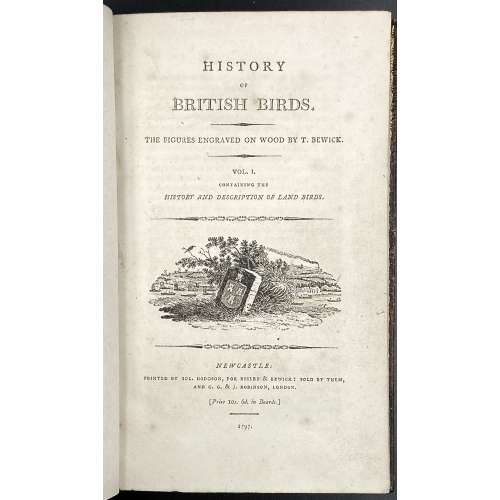 Volume 1: Title: HISTORY | OF | BRITISH BIRDS. | THE FIGURES ENGRAVED ON WOOD BY T. BEWICK. | VOL. I. | CONTAINING THE | HISTORY AND DESCRIPTION OF LAND BIRDS. | [Vignette] | NEWCASTLE: | PRINTED BY SOL. HODGSON, FOR BEILBY & BEWICK : SOLD BY THEM, | AND G. G. & J. ROBINSON, LONDON. | [Price 10s 6d. in Boards] | 1797|| Pagination: [2 blanks], [i, ii] – t.p. / blank, [iii] iv-xxx, [2] – f.t. / blank, [1] 2-335 [336 advert.] [2 blanks]; vignettes on t.p.'s; head- and tail-pieces; publisher's advertisement on final p. of v. 1. Collation: demi 8vo; a-b8, B-Y8; no sigs. A, p. 279 numbered correctly. Woodcuts: 140 descriptions of birds, 117 figures of birds, 91 vignettes, tail-pieces, etc. 1,000 copies printed. Variant B with a vignette at p. 22 printed vertically. Vignette at p. 285 without bars. Volume 2: Title: HISTORY | OF | BRITISH BIRDS. | THE FIGURES ENGRAVED ON WOOD BY T. BEWICK. | VOL. I. | CONTAINING THE | HISTORY AND DESCRIPTION OF WATER BIRDS. | [Vignette] | NEWCASTLE: | PRINTED BY EDWARD WALKER, FOR T. BEWICK : SOLD BY HIM, AND | LONGMAN AND REES, LONDON. | [Price 12s in Boards] | 1804|| Pagination: [2 blanks], [i, ii] – t.p. / blank; [iii] iv-xx, [1] 2-400, [2 blanks]. Collation: Demy 8vo in fours; a2 b-c4, A-3D4; E2, P2, Cc2 insigned. Woodcuts: 144 descriptions of birds, 101 figures of birds, 136 vignettes, tail-pieces, etc. Variant C: Vignette on p. 136 in 1st state, vignettes on pp. 269 and 359 in 2nd state. Binding: speckled full brown calf (restored), contemporary boards ruled in gilt, later spine with raised bands, gilt lettering and florets in compartments, marbled endpapers; 261 woodcut illustrations; printed on wove paper. In both volumes: armorial bookplate of "Clark, Knedlington, Yorks." with the motto "The time will come" on the front pastedown. Size: 21.5 x 14 cm, page: 20.6 x 12.6 cm, demi 8vo. Catalogue raisonné: Hugo (1866): № (99) 94 –120 (108) / pp. 40-58; Roscoe (1953): № 14 a-d, 17 a-d / pp. 46-52 and 65-76. See later edition in this collection: LIB-0860.2015.
Volume 1: Title: HISTORY | OF | BRITISH BIRDS. | THE FIGURES ENGRAVED ON WOOD BY T. BEWICK. | VOL. I. | CONTAINING THE | HISTORY AND DESCRIPTION OF LAND BIRDS. | [Vignette] | NEWCASTLE: | PRINTED BY SOL. HODGSON, FOR BEILBY & BEWICK : SOLD BY THEM, | AND G. G. & J. ROBINSON, LONDON. | [Price 10s 6d. in Boards] | 1797|| Pagination: [2 blanks], [i, ii] – t.p. / blank, [iii] iv-xxx, [2] – f.t. / blank, [1] 2-335 [336 advert.] [2 blanks]; vignettes on t.p.'s; head- and tail-pieces; publisher's advertisement on final p. of v. 1. Collation: demi 8vo; a-b8, B-Y8; no sigs. A, p. 279 numbered correctly. Woodcuts: 140 descriptions of birds, 117 figures of birds, 91 vignettes, tail-pieces, etc. 1,000 copies printed. Variant B with a vignette at p. 22 printed vertically. Vignette at p. 285 without bars. Volume 2: Title: HISTORY | OF | BRITISH BIRDS. | THE FIGURES ENGRAVED ON WOOD BY T. BEWICK. | VOL. I. | CONTAINING THE | HISTORY AND DESCRIPTION OF WATER BIRDS. | [Vignette] | NEWCASTLE: | PRINTED BY EDWARD WALKER, FOR T. BEWICK : SOLD BY HIM, AND | LONGMAN AND REES, LONDON. | [Price 12s in Boards] | 1804|| Pagination: [2 blanks], [i, ii] – t.p. / blank; [iii] iv-xx, [1] 2-400, [2 blanks]. Collation: Demy 8vo in fours; a2 b-c4, A-3D4; E2, P2, Cc2 insigned. Woodcuts: 144 descriptions of birds, 101 figures of birds, 136 vignettes, tail-pieces, etc. Variant C: Vignette on p. 136 in 1st state, vignettes on pp. 269 and 359 in 2nd state. Binding: speckled full brown calf (restored), contemporary boards ruled in gilt, later spine with raised bands, gilt lettering and florets in compartments, marbled endpapers; 261 woodcut illustrations; printed on wove paper. In both volumes: armorial bookplate of "Clark, Knedlington, Yorks." with the motto "The time will come" on the front pastedown. Size: 21.5 x 14 cm, page: 20.6 x 12.6 cm, demi 8vo. Catalogue raisonné: Hugo (1866): № (99) 94 –120 (108) / pp. 40-58; Roscoe (1953): № 14 a-d, 17 a-d / pp. 46-52 and 65-76. See later edition in this collection: LIB-0860.2015. -
![[Voltaire]. La Henriade, nouvelle édition / 2 Vol. — Paris: la Veuve Duchesne, Saillant, Desaint, Panckoucke et Nyon, [1769]-1770.](https://varshavskycollection.com/wp-content/uploads/2021/02/LIB-2581-1.2020-1-4-500x500.jpeg) A two-volume set. Vol. 1: LA | HENRIADE, | NOUVELLE ÉDITION | A PARIS | [medallion portrait of Voltaire] | Chez la Veuve Duchesne, Saillant, Desaint, | Panckoucke et Nyon, Libraires. || Pagination: [2] – engraved title with medallion portrait of Voltaire / blank, [i-iii] iv-xl, [1-3] 4-272, 10 plates and 10 vignettes after Eisen by de Longueil. Collation: 8vo; a-b8 c4, A-R8 Vol. 2: LA | HENRIADE, | NOUVELLE ÉDITION. | — | SECONDE PARTIE. |— | [Floral device] | A PARIS, | Chez la Veuve Duchesne, Saillant, Desaint, | Panckoucke et Nyon, Libraires. | — | M. DCC. LXX. Pagination: [1, 2] - t.p. / imprim., 3-316 [4 - table, imprint "De l'Imprimerie de Barbou."] Collation: A-V8. Binding: full brown calf, raised bands with the gilt floral tools in compartments, red and dark brown labels with gilt lettering: title, author, vol. number, and year; printed on laid paper. Wear, marks and rubbing, endpapers, corners and spine repaired/replaced; leaves are generally clean with the odd mark here or there. With frontispiece, 10 vignettes and 10 plates in vol. 1 as called for. Size: 19 x 12.5 cm each volume. Catalogue raisonné.: G. Ray, p. 59; Cohen-de Ricci p. 1026. LIB-2581-1.2020 and LIB-2581-2.2020.Illustrated by: Charles Eisen (French, 1720 – 1778) Engraved by: Joseph de Longueil (French, 1730 – 1792) Author: François Marie Arouet de Voltaire (French, 1694 – 1778) Publisher: Veuve Duchesne (Nicolas Bonaventure Duchesne died in 1765) Printer: Joseph Gérard Barbou (French, 1723 – 1790)
A two-volume set. Vol. 1: LA | HENRIADE, | NOUVELLE ÉDITION | A PARIS | [medallion portrait of Voltaire] | Chez la Veuve Duchesne, Saillant, Desaint, | Panckoucke et Nyon, Libraires. || Pagination: [2] – engraved title with medallion portrait of Voltaire / blank, [i-iii] iv-xl, [1-3] 4-272, 10 plates and 10 vignettes after Eisen by de Longueil. Collation: 8vo; a-b8 c4, A-R8 Vol. 2: LA | HENRIADE, | NOUVELLE ÉDITION. | — | SECONDE PARTIE. |— | [Floral device] | A PARIS, | Chez la Veuve Duchesne, Saillant, Desaint, | Panckoucke et Nyon, Libraires. | — | M. DCC. LXX. Pagination: [1, 2] - t.p. / imprim., 3-316 [4 - table, imprint "De l'Imprimerie de Barbou."] Collation: A-V8. Binding: full brown calf, raised bands with the gilt floral tools in compartments, red and dark brown labels with gilt lettering: title, author, vol. number, and year; printed on laid paper. Wear, marks and rubbing, endpapers, corners and spine repaired/replaced; leaves are generally clean with the odd mark here or there. With frontispiece, 10 vignettes and 10 plates in vol. 1 as called for. Size: 19 x 12.5 cm each volume. Catalogue raisonné.: G. Ray, p. 59; Cohen-de Ricci p. 1026. LIB-2581-1.2020 and LIB-2581-2.2020.Illustrated by: Charles Eisen (French, 1720 – 1778) Engraved by: Joseph de Longueil (French, 1730 – 1792) Author: François Marie Arouet de Voltaire (French, 1694 – 1778) Publisher: Veuve Duchesne (Nicolas Bonaventure Duchesne died in 1765) Printer: Joseph Gérard Barbou (French, 1723 – 1790) -
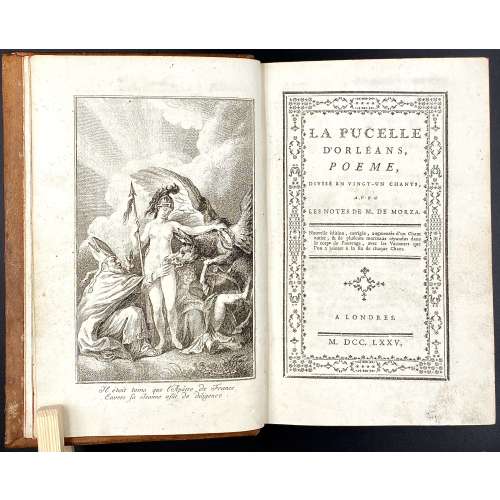 Half title: LA PUCELLE | D’ORLEANS.|| Title: LA PUCELLE | D’ORLEANS , | POEME , | DIVISÉ EN VINGT-UN CHANTS , AVEC | LES NOTES DE M. DE MORZA. | Nouvelle édition, corrigée, augmentée d'un Chant | entier, & de plusieurs morceaux répandus dans | le corps de l'ouvrage, avec les Variantes que | l'on a jointes à la fin de chaque Chant. | [ornament] | A LONDRES. |—| M. DCC. LXXV. || Pagination : [4] – two blank unnumbered fly leaves, [i,ii] – h.t. / double-ruled blank leaf, [2] – blank / frontispiece on verso, [iii, iv] – t.p. ruled and bordered / double-ruled blank leaf, [v]vi-viii – table, ix-xv – preface, [xvi] – double-ruled blank leaf, [1]2-447 [448] – double-ruled blank leaf, [2] – two blank unnumbered fly leaves; page 14 misnumbered 18; title within ornamental border; text within double-ruled borders; head- and tail-pieces; 22 leaves of plates (frontis. + one before each chant.) Collation: 8vo; a8 A-Z8 Aa-Ee8 Binding: 19.9 x 13.2 cm; full contemporary brown calf, blind ruled plates, spine with raised bands, gilt-ruled and tooled in compartments, red label with gilt lettering, all edges red; plate for chant 6, H4, H5 - separated from the block. De Morza is Voltaire (Cf. Quérard, v. 10, p. 306). Engravings unsigned; attributed to Desrais, Claude-Louis (French, 1746 – 1816). False imprint; possibly printed in Paris.
Half title: LA PUCELLE | D’ORLEANS.|| Title: LA PUCELLE | D’ORLEANS , | POEME , | DIVISÉ EN VINGT-UN CHANTS , AVEC | LES NOTES DE M. DE MORZA. | Nouvelle édition, corrigée, augmentée d'un Chant | entier, & de plusieurs morceaux répandus dans | le corps de l'ouvrage, avec les Variantes que | l'on a jointes à la fin de chaque Chant. | [ornament] | A LONDRES. |—| M. DCC. LXXV. || Pagination : [4] – two blank unnumbered fly leaves, [i,ii] – h.t. / double-ruled blank leaf, [2] – blank / frontispiece on verso, [iii, iv] – t.p. ruled and bordered / double-ruled blank leaf, [v]vi-viii – table, ix-xv – preface, [xvi] – double-ruled blank leaf, [1]2-447 [448] – double-ruled blank leaf, [2] – two blank unnumbered fly leaves; page 14 misnumbered 18; title within ornamental border; text within double-ruled borders; head- and tail-pieces; 22 leaves of plates (frontis. + one before each chant.) Collation: 8vo; a8 A-Z8 Aa-Ee8 Binding: 19.9 x 13.2 cm; full contemporary brown calf, blind ruled plates, spine with raised bands, gilt-ruled and tooled in compartments, red label with gilt lettering, all edges red; plate for chant 6, H4, H5 - separated from the block. De Morza is Voltaire (Cf. Quérard, v. 10, p. 306). Engravings unsigned; attributed to Desrais, Claude-Louis (French, 1746 – 1816). False imprint; possibly printed in Paris. -
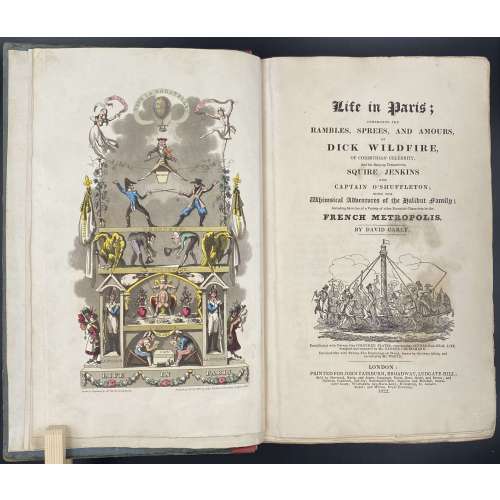
Title: Life in Paris ; | COMPRISING THE | RAMBLES, SPREES, AND AMOURS, | OF | DICK WILDFIRE, | OF CORINTHIAN CELEBRITY, | And his Bang-up Companions, SQUARE JENKINS | AND | CAPTAIN O’SHUFFLETON ; | WITH THE | Whimsical Adventures of the Halibut family ; | Including Sketches of a Variety of other Eccentric Characters in the | FRENCH METROPOLIS. | BY DAVID CAREY |[Vignette]| Embellished with Twenty-One COLOURED PLATES, representing SCENES from REAL LIFE, | designed and engraved by Mr. GEORGE CRUIKSHANK. | Enriched also with Twenty-Two Engravings on Wood, drawn by the same Artist, and | executed by Mr. WHITE. | LONDON : | PRINTED FOR JOHN FAIRBURN, BROADWAY, LUDGATE HILL; | Sold by Sherwood, Neely, and Jones ; Langman, Hurst, Rees, Orme, and Brown ; and | Baldwin, Craddoc, and Joy ; Paternoster-Row ; Simpkin and Marshall, Statio- | ners’ Court ; Whittakers Ave-Maria-Lane ; Humphrey, St. James’s | Street ; and Wilson, Royal Exchange. | 1822. ||
Edition: 1st edition in book form, 1st issue; large-paper copy bound from the parts in original blue paper boards, "most scarce" (Cohn).
Pagination: ffl, [i, ii] – h.t. ‘LIFE IN PARIS’ / ‘MARCHANT, Printer, Ingram-Court, London’, [2] – blank / Frontispiece (Ville la Bagatelle!!) hand-coloured, [iii, iv] – t.p. with vignette / blank, [v] vi-xxiv, [1] 2-489 [490 blank], [2] – 'TO THE BINDER' and 'Marchant, Printer, Ingram-Court, Fenchurch Street' "considered indispensable to a complete copy" (Cohn) / blank, bfl watermarked 1800; 21 hand-coloured aquatints and 22 wood-engraved text vignettes; cancelled leaves 143/4 and 335/6; pinholes from printing visible in most gatherings.
Collation: 4to; [a]-c4, B-Z4 Aa-Zz4 3A-3Q4 3R1 + [Ω]1
Binding: Original boards sometime re-backed with red paper, binder's end leaf watermarked 1800; red hard-grained morocco clamshell box.
Catalogue raisonné: Albert M. Cohn, 1924: № 109 p. 37/8; Abbey, J. R. (Life in England), 112; Tooley (Some English Books with Coloured Plates) 129; Hardie (English coloured books) 199.
Description of Shapero Rare Books, London: Of the copies that have come to auction since 1975 only one has been a large-paper copy in original boards. "The pictures are extremely spirited and true and are all the more wonderful in view of the fact that the artist’s continental experiences were limited to one day spent in Boulogne." (Hardie). In 1821, the journalist Pierce Egan published Life in London, an immediate success illustrated by the Cruikshank brothers, George and Robert. In order to capitalise on this success, another journalist, David Carey, decided to publish his own Life in Paris in monthly instalments (just like Life in London) and with a very similar frontispiece to the one that appears in Egan’s work; Life in Paris, however, was illustrated only by George Cruikshank. One of the earliest and most notable examples of the work of George Cruikshank, with fine, clean plates. -
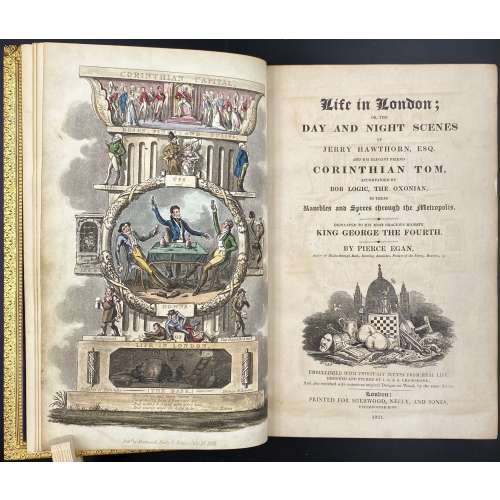
Title: Life in London ; | DAY AND NIGHT SCENES | OF | JERRY HAWTHORN, ESQ. | AND HIS ELEGANT FRIEND | CORINTHIAN TOM, | ACCOMPANIED BY | BOB LOGIC, THE OXONIAN, | IN THEIR |Rambles and Sprees through the Metropolis. | DEDICATED TO HIS MOST GRACIOUS MAJESTY | KING GEORGE THE FOURTH. | BY PIERCE EGAN, | Author of Walks through Bath, Sporting Anecdotes, Picture of the Fancy, Boxiana, &c. | [Vignette] | EMBELLISHED WITH THIRTY-SIX SCENES FROM REAL LIFE, | DESIGNED AND ETCHED BY I. R. & G. CRUIKSHANK ; | And also enriched with numerous original Designs on Wood, by the same Artists, | London: | PRINTED FOR SHERWOOD, NEELY, AND JONES, | PATERNOSTER-ROW. | 1821. ||
Edition: 1st edition, 1st issue: the first sheet of music is not numbered, absence of any footnote at page 9 (as per Cohn).
Pagination: 3 binder's flyleaves with a specimen of George Cruikshank's signature of Nov. 5th, 1860 to the first one; hand-coloured aquatint frontispiece facing the title page with blank recto, [iii-iv] – t.p. with vignette/ blank, [v] vi-viii – dedication, ix-xii – contents, [xiii]-xvi – list of illustrations; [1] 2-376; 35 hand-coloured aquatints, 3 folding leaves of music; bound without half-title [missing pp. i, ii], advertisements or 'to the subscribers' leaf.
Collation: 8vo; [A]7 B-Z8 Aa8-Bb4.
Binding: Full polished calf gilt by Rivière & Son, covers with triple gilt border, spine in 6 compartments, brown morocco lettering pieces to second and third, others richly gilt, raised bands, all edges gilt; neatly re-backed preserving spine.
Catalogue raisonné: Albert M. Cohn, 1924: № 262 p. 90; Abbey, J. R. (Life in England), 281; Tooley (Some English Books with Coloured Plates) 196; Prideaux (Aquatint Engraving) pp. 307, 310; Hardie (English coloured books) 197.
Description of Shapero Rare Books, London: There was a translation into French. At least six plays were based on Egan's characters, contributing to yet more sales. One of these was exported to America, launching the Tom and Jerry craze there. The version created by William Thomas Moncrieff was praised as The Beggar's Opera of its day. Moncrieff's production of Tom and Jerry, or Life in London ran continuously at the Adelphi Theatre for two seasons and it was the dramatist's work as much as the author's that did so much to popularise the book's trademark use of fashionable slang. In 1821 Egan announced the publication of a regular journal: Life in London, appearing monthly at a shilling a time. It was to be illustrated by George Cruikshank (1792 – 1878), and was dedicated to the King, George IV, who at one time had received Egan at court. The first edition of Life in London appeared on 15 July 1821. Egan's creation was an instant success. Pirate versions appeared, featuring such figures as 'Bob Tallyho', 'Dick Wildfire' and the like. Printmakers speedily knocked off cuts featuring the various 'stars' and the real-life public flocked to the 'sporting' addresses that Egan had his heroes frequent. -
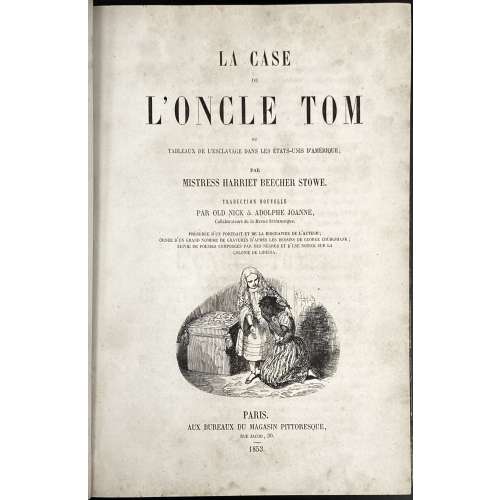 1st French edition (Paris, 1853) of Harriet Beecher Stowe's book Uncle Tom's Cabin; or, Life Among the Lowly, with 27 illustrations on wood by George Cruikshank (British, 1792 – 1878), translated into French by Paul-Émile Daurand-Forgues [pseudonym Old Nick] (French, 1813 – 1883) and Adolphe Joanne (French, 1813 – 1881). Title: LA CASE | DE | L'ONCLE TOM | OU | TABLE AUX DE L'ESCLAVAGE DANS LES ÉTATS-UNIS D'AMÉRIQUE ; | PAR MISTRESS HARRIET BEECHER STOWE. | TRADUCTION NOUVELLE | PAR OLD NICK & ADOLPHE JOANNE, | Collaboarteurs de la Revue britannique, | PRÉCÉDÉE D'UN PORTRAIT ET DE LA BIOGRAPHIE DE L'AUTEUR; | ORNÉE D'IU GRAND NOMBRE DE GRAVURES D'APRES LES DESSINS DE GEORGE CRUIKSHANK ; | SUIVIE DE POÉSIES COMPOSÉES PAR DES NÈGRES ET D'UNE NOTICE SUR LA | COLONIE DE LIBERIA. | [vignette] | PARIS. | AUX BUREAUX DU MAGASIN PITTORESQUE, | RUE JACOB, 30. | 1853. Pagination: ffl blank; [i-ii]: h.t. with stamped letters D. W. in the upper centre / imprim. to verso; [iii-iv] t.p. / blank; [v-vi] blank / frontispiece: portrait of Harriet Beecher Stowe, half-length to left, with hair in ringlets, and a shawl over shoulders, landscape behind, Henry Linton (British, 1815 – 1899) after Henry Anelay (British,1817 – 1883), wood-engraving with letterpress; [vij] Viij-xij; [1] 2-563 [564]; bfl blank; illustrations: 27 woodcuts by George Cruikshank. Collation: 8vo, π7 (1)–(35)8 363 Binding: Quarter brown calf, spine with raised bands, gilt-ruled compartments, title lettering, "D. W." in the bottom, marbled boards and endpapers. Dimensions: 24.1 x 16.4 cm. Catalogue raisonné: Albert M. Cohen (1924), №777, p. 221. "An edition was published in French with the woodcuts direct from the blocks, not, as in the English, merely from the stereotypes. The illustrations are far more impressive than those of Cassell's edition".
1st French edition (Paris, 1853) of Harriet Beecher Stowe's book Uncle Tom's Cabin; or, Life Among the Lowly, with 27 illustrations on wood by George Cruikshank (British, 1792 – 1878), translated into French by Paul-Émile Daurand-Forgues [pseudonym Old Nick] (French, 1813 – 1883) and Adolphe Joanne (French, 1813 – 1881). Title: LA CASE | DE | L'ONCLE TOM | OU | TABLE AUX DE L'ESCLAVAGE DANS LES ÉTATS-UNIS D'AMÉRIQUE ; | PAR MISTRESS HARRIET BEECHER STOWE. | TRADUCTION NOUVELLE | PAR OLD NICK & ADOLPHE JOANNE, | Collaboarteurs de la Revue britannique, | PRÉCÉDÉE D'UN PORTRAIT ET DE LA BIOGRAPHIE DE L'AUTEUR; | ORNÉE D'IU GRAND NOMBRE DE GRAVURES D'APRES LES DESSINS DE GEORGE CRUIKSHANK ; | SUIVIE DE POÉSIES COMPOSÉES PAR DES NÈGRES ET D'UNE NOTICE SUR LA | COLONIE DE LIBERIA. | [vignette] | PARIS. | AUX BUREAUX DU MAGASIN PITTORESQUE, | RUE JACOB, 30. | 1853. Pagination: ffl blank; [i-ii]: h.t. with stamped letters D. W. in the upper centre / imprim. to verso; [iii-iv] t.p. / blank; [v-vi] blank / frontispiece: portrait of Harriet Beecher Stowe, half-length to left, with hair in ringlets, and a shawl over shoulders, landscape behind, Henry Linton (British, 1815 – 1899) after Henry Anelay (British,1817 – 1883), wood-engraving with letterpress; [vij] Viij-xij; [1] 2-563 [564]; bfl blank; illustrations: 27 woodcuts by George Cruikshank. Collation: 8vo, π7 (1)–(35)8 363 Binding: Quarter brown calf, spine with raised bands, gilt-ruled compartments, title lettering, "D. W." in the bottom, marbled boards and endpapers. Dimensions: 24.1 x 16.4 cm. Catalogue raisonné: Albert M. Cohen (1924), №777, p. 221. "An edition was published in French with the woodcuts direct from the blocks, not, as in the English, merely from the stereotypes. The illustrations are far more impressive than those of Cassell's edition". -
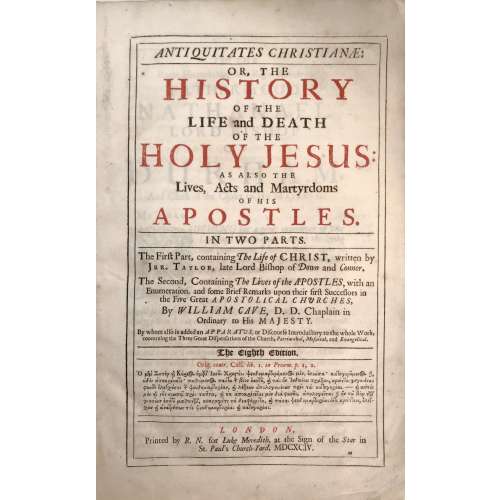 Title (black and red): ANTIQUITATES CHRISTIANÆ: |—| OR, THE | HISTORY | OF THE | LIFE AND DEATH | OF THE | HOLY JESUS: | AS ALSO THE Lives, Acts and Martyrdoms | OF HIS | APOSTLES. |—| IN TWO PARTS. |—| The Firƒt Part, containing The Life of CHRIST, written by | Jer. Taylor, Late Lord Bishop of Down and Connor. | The Second, Containing The Lives of the APOSTLES, with an | Enumeration, and ƒome Brief Remarks upon their firƒt Successors in | the Five Great APOSTOLICAL CHURCHES, | By WILLIAM CAVE, D. D. Chaplain in | Ordinary to His MAJESTY. | By whom alƒo is added an APPARATUS, or Diƒcourƒe Introductory to the whole Work, | concerning the Three Great Diƒpenƒations of the Church, Patriarchal, Moƒaical, and Evangelical. |—| THE EIGHTH EDITION. |—| Orig. contr. Celƒ. lib. 1. in Proœm. p. 1, 2. | [text in Greek] |—| LONDON, | Printed by R. N. for Luke Meredith, at the Sign of the Star in | St. Paul's Church-Yard, MDCXCIV. Collation of this book is unusual, it is called "Folio in 6s" (three sheets are folded in half to create a gathering of 6 leaves). Two unsigned leaves: (1) Engraved frontispiece "The Annunciation" by Willian Faithorne "the Elder" (British, 1616 – 1691), recto blank; (2) engraved title by the same engraver, verso blank; (*) gathering of 4: black and red title page, verso blank; epistle; to reader; imprim. (A6 to Sƒ6) Engraved portrait of Jeremy Taylor by Pierre Lombart (French, 1612 – 1682); faux title page: "The Great Exemplar of Sanctity and Holy Life... MDCXCIII"; dedication; contents, then to the end of the first book. (A-Z4 Aa-Bb4 Cc2) The second book has collation in quarto: Faux title page: "Antiquitates Christianæ: or the Lives, Acts and Martyrdoms... MDCXCIV", etc. to the end. Full formula: π2 *4 a-c6 d8 A-Z6 Aa-Sƒ6 A-Z4 Aa-Bb4 Cc2 Pagination: [12] I-LI [LII] [12] I-XXVIII, i-vi, (1st book): [2] I-145 [146-150] 151-432 [12]; (2nd book): [8] i-xiv, 1-188. 22 plates : frontis., t.p., portrait, one folding before p. 65, two after pp. [146], [150], 282, 304, 364, 386, 414, [422], and numerous head-pieces. Size: 36 x 23.5 x 5.7 cm Binding: full calf with the later spine, raised bands; front board with remnants of gilt ruling and blind stamped border, back bord probably original with a blind-stamped centre panel with fleurons.
Title (black and red): ANTIQUITATES CHRISTIANÆ: |—| OR, THE | HISTORY | OF THE | LIFE AND DEATH | OF THE | HOLY JESUS: | AS ALSO THE Lives, Acts and Martyrdoms | OF HIS | APOSTLES. |—| IN TWO PARTS. |—| The Firƒt Part, containing The Life of CHRIST, written by | Jer. Taylor, Late Lord Bishop of Down and Connor. | The Second, Containing The Lives of the APOSTLES, with an | Enumeration, and ƒome Brief Remarks upon their firƒt Successors in | the Five Great APOSTOLICAL CHURCHES, | By WILLIAM CAVE, D. D. Chaplain in | Ordinary to His MAJESTY. | By whom alƒo is added an APPARATUS, or Diƒcourƒe Introductory to the whole Work, | concerning the Three Great Diƒpenƒations of the Church, Patriarchal, Moƒaical, and Evangelical. |—| THE EIGHTH EDITION. |—| Orig. contr. Celƒ. lib. 1. in Proœm. p. 1, 2. | [text in Greek] |—| LONDON, | Printed by R. N. for Luke Meredith, at the Sign of the Star in | St. Paul's Church-Yard, MDCXCIV. Collation of this book is unusual, it is called "Folio in 6s" (three sheets are folded in half to create a gathering of 6 leaves). Two unsigned leaves: (1) Engraved frontispiece "The Annunciation" by Willian Faithorne "the Elder" (British, 1616 – 1691), recto blank; (2) engraved title by the same engraver, verso blank; (*) gathering of 4: black and red title page, verso blank; epistle; to reader; imprim. (A6 to Sƒ6) Engraved portrait of Jeremy Taylor by Pierre Lombart (French, 1612 – 1682); faux title page: "The Great Exemplar of Sanctity and Holy Life... MDCXCIII"; dedication; contents, then to the end of the first book. (A-Z4 Aa-Bb4 Cc2) The second book has collation in quarto: Faux title page: "Antiquitates Christianæ: or the Lives, Acts and Martyrdoms... MDCXCIV", etc. to the end. Full formula: π2 *4 a-c6 d8 A-Z6 Aa-Sƒ6 A-Z4 Aa-Bb4 Cc2 Pagination: [12] I-LI [LII] [12] I-XXVIII, i-vi, (1st book): [2] I-145 [146-150] 151-432 [12]; (2nd book): [8] i-xiv, 1-188. 22 plates : frontis., t.p., portrait, one folding before p. 65, two after pp. [146], [150], 282, 304, 364, 386, 414, [422], and numerous head-pieces. Size: 36 x 23.5 x 5.7 cm Binding: full calf with the later spine, raised bands; front board with remnants of gilt ruling and blind stamped border, back bord probably original with a blind-stamped centre panel with fleurons.


